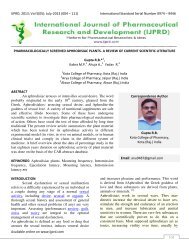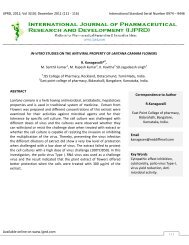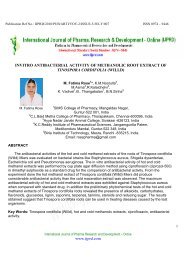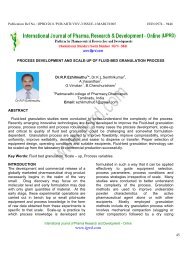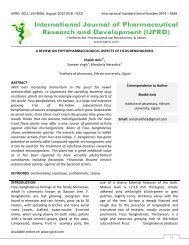Ethno-medico botany of medicinal plants for the - IJPRD
Ethno-medico botany of medicinal plants for the - IJPRD
Ethno-medico botany of medicinal plants for the - IJPRD
Create successful ePaper yourself
Turn your PDF publications into a flip-book with our unique Google optimized e-Paper software.
Publication Ref No.: <strong>IJPRD</strong>/2009/PUB/ARTI/VOL-8/OCT/008 ISSN 0974 – 9446<br />
(SURVEY ARTICLE)<br />
ETHNO-MEDICO BOTANY OF MEDICINAL PLANTS FOR THE TREATMENT OF DIABETIC<br />
ACTIVITY IN KRISHNA DISTRICT, ANDHRA PRADESH<br />
Phani Ratna Prasanth .G * , Ashok Kumar.D<br />
Department <strong>of</strong> Pharmacognosy and Phytochemistry,<br />
Dr.H.L.Thimme Gowda College <strong>of</strong> Pharmacy, Kengal, Channapatna, Ramanagaram District, Karnataka –<br />
571502.<br />
ABSTRACT<br />
Around 70% <strong>of</strong> population in India relies on <strong>the</strong>se systems <strong>for</strong> primary health care. Ayurveda and Indian<br />
System <strong>of</strong> Medicine (ISM) utilize a vast number <strong>of</strong> <strong>plants</strong>. The traditional Indian system <strong>of</strong> medicine<br />
includes many natural <strong>plants</strong> used <strong>for</strong> <strong>the</strong> treatment <strong>of</strong> diabetic activity. In <strong>the</strong> present study, <strong>the</strong> herbal<br />
remedies used <strong>for</strong> diabetic treatment in Krishna district, which is located in coastal region <strong>of</strong> Andhra<br />
Pradesh, India are discussed. A total number <strong>of</strong> around twenty-five <strong>plants</strong> such as Eugenia jambolana,<br />
Ocimum sanctum, Phyllanthus amarus, Pterocarpus marsupium, Tinospora cordifolia, Curcuma longa<br />
and Trigonella foenum graecum etc. from various families used <strong>the</strong>rapeutically against diabetes and<br />
related disorders are being covered, which includes Biological source, family, parts <strong>of</strong> <strong>the</strong> plant used,<br />
regional name, local use and <strong>the</strong>rapeutic action (traditional use) <strong>for</strong> all <strong>the</strong> natural <strong>plants</strong>. This detailed<br />
in<strong>for</strong>mation will be helpful <strong>for</strong> <strong>the</strong> pharmacognosist, botanist, phytochemist and pharmacologist <strong>for</strong> <strong>the</strong><br />
collection and identification <strong>of</strong> <strong>the</strong> plant <strong>for</strong> <strong>the</strong>ir research work.<br />
Key words: <strong>Ethno</strong>-<strong>medico</strong> <strong>botany</strong>, Herbal drugs, Anti-diabetic, Krishna district<br />
International Journal <strong>of</strong> Pharma Research and Development – Online<br />
www.ijprd.com<br />
1
Publication Ref No.: <strong>IJPRD</strong>/2009/PUB/ARTI/VOL-8/OCT/008 ISSN 0974 – 9446<br />
INTRODUCTION AND MATERIALS AND METHODS<br />
INTRODUCTION<br />
The art <strong>of</strong> herbal treatment has very deep roots in Indian culture. Even today in most <strong>of</strong> <strong>the</strong> rural areas<br />
people are depending on herbal drug systems <strong>for</strong> primary health care. The present paper deals with <strong>the</strong><br />
first hand in<strong>for</strong>mation <strong>of</strong> <strong>the</strong> traditional <strong>medicinal</strong> claims referring to treat diabetes in <strong>the</strong> district <strong>of</strong> Krishna<br />
in Andhra Pradesh. So far no systematic medical ethno survey has been made in this area. The goal <strong>of</strong><br />
this ethno <strong>medico</strong> botanical survey is to ga<strong>the</strong>r in<strong>for</strong>mation on Biological source, family, parts <strong>of</strong> <strong>the</strong> plant<br />
used, regional name, local use and <strong>the</strong>rapeutic uses (traditional use) along with chemical constituents<br />
and such survey is to know about <strong>the</strong> use <strong>of</strong> drugs from natural <strong>medicinal</strong> <strong>plants</strong> <strong>for</strong> <strong>the</strong> treatment <strong>of</strong><br />
Diabetes.<br />
MATERIALS AND METHODS<br />
Study Area<br />
Krishna district is one <strong>of</strong> <strong>the</strong> 23 districts in <strong>the</strong> state and one <strong>of</strong> <strong>the</strong> nine districts in <strong>the</strong> costal region <strong>of</strong><br />
state Andhra Pradesh located in central area <strong>of</strong> this region. The elevation above <strong>the</strong> mean sea level<br />
ranges from 45 mts. The climate is tropical with three different seasons in a year such as summer<br />
(march-mid June), rainy (mid June- Sep), winter (Oct – Feb). October and March constitute that transition<br />
months between <strong>the</strong> rainy and winter seasons and winter and summer seasons respectively.<br />
International Journal <strong>of</strong> Pharma Research and Development – Online<br />
www.ijprd.com<br />
2
Publication Ref No.: <strong>IJPRD</strong>/2009/PUB/ARTI/VOL-8/OCT/008 ISSN 0974 – 9446<br />
Fig. 1 & 2: Krishna District <strong>of</strong> Andhra Pradesh<br />
The present study is based on <strong>the</strong> intensive field <strong>of</strong> <strong>the</strong> area during <strong>the</strong> period <strong>of</strong> Feb-July 2008. Regular<br />
field studies were made in <strong>the</strong> study area during <strong>the</strong> period. The in<strong>for</strong>mation about <strong>the</strong> <strong>plants</strong> used <strong>for</strong><br />
diabetes was ga<strong>the</strong>red through interviews and discussion with <strong>the</strong> elderly people and traditional medical<br />
practitioners were also consulted. Herbal <strong>plants</strong> referred by <strong>the</strong>se people were au<strong>the</strong>ntically identified<br />
with <strong>the</strong> help <strong>of</strong> pharmacognosist and botanist (Fig 1 & 2).<br />
RESULTS<br />
All toge<strong>the</strong>r <strong>plants</strong> belonging to different families have been documented <strong>for</strong> <strong>the</strong>ir <strong>the</strong>rapeutic properties<br />
and diabetes. The collected in<strong>for</strong>mation’s are arranged in <strong>the</strong> alphabetic order <strong>of</strong> <strong>the</strong> plant botanical<br />
name with <strong>the</strong> local (or) common name, vernacular names, parts used, local use, active constituents and<br />
<strong>the</strong>rapeutic action <strong>for</strong> each plant 1, 2, 3, and 4 (Table I).<br />
DISCUSSION<br />
Among <strong>the</strong> <strong>plants</strong> used <strong>for</strong> <strong>the</strong> diabetes, “Eugenia jambolana, Curcuma longa and Trigonella foenum<br />
graecum” seems to be most common <strong>plants</strong> used to treat diabetes and is available everywhere. Along<br />
with <strong>the</strong>se Triphala and Momordica charantia listed which are <strong>the</strong> major traditional drugs <strong>for</strong> treating this<br />
diseases. The detailed natural <strong>plants</strong> not only used <strong>for</strong> <strong>the</strong> treatment <strong>of</strong> diabetes but also treated <strong>for</strong> o<strong>the</strong>r<br />
ailments also. The in<strong>for</strong>mation collected from <strong>the</strong> people <strong>of</strong> that area was reexamined by consulting<br />
important works pertaining to Indian Medicinal <strong>plants</strong> and <strong>Ethno</strong><strong>botany</strong> such as Wealth <strong>of</strong> India<br />
(Anonymous, 1992), Indian Medicinal Plants (Kithikar and Basu, 1975), Indian Material Medica<br />
(Nadkarni, 2002) and Indigenous Drugs <strong>of</strong> India (Dey, 1973) 5,6,7,8 .<br />
CONCLUSION<br />
The claims emanating from <strong>the</strong> present survey need to be subjected to pharmacochemical studies in<br />
order to discover <strong>the</strong>ir true potential, as it is very difficult to judge <strong>the</strong> effectiveness <strong>of</strong> herbal medicine.<br />
The main purpose is not to prescribe any remedies <strong>for</strong> any <strong>of</strong> <strong>the</strong> diseases but to document <strong>the</strong> uses and<br />
draw <strong>the</strong> attention <strong>of</strong> pharmacognosist, botanist, phytochemist and pharmacologist <strong>for</strong> fur<strong>the</strong>r scientific<br />
research in this area.<br />
International Journal <strong>of</strong> Pharma Research and Development – Online<br />
www.ijprd.com<br />
3
Publication Ref No.: <strong>IJPRD</strong>/2009/PUB/ARTI/VOL-8/OCT/008 ISSN 0974 – 9446<br />
S. No Biological<br />
Source<br />
01 Abroma<br />
augusta<br />
(Sterculiaceae)<br />
02 Aconitum ferox<br />
(Ranunculaceae)<br />
03 Andrographis<br />
paniculata<br />
(Acanthaceae)<br />
04 Cassia auriculata<br />
(Caesalpiniaceae<br />
)<br />
05 Cassia fistula<br />
(Cagesalpiniacea<br />
e)<br />
06 Cassia sophora<br />
(Caesalpiniaceae<br />
)<br />
Table 1: List <strong>of</strong> <strong>medicinal</strong> <strong>plants</strong> used <strong>for</strong> <strong>the</strong> treatment <strong>of</strong> Diabetic activity<br />
Common Local Part Used Active<br />
Name Name<br />
Constituents<br />
Devils cotton Perita Root, Root Alkaloids,<br />
bark,<br />
Stems,<br />
Leaves<br />
Fixed oil<br />
Bachnag Vasanubhi Tuberous Alkaloidsroot<br />
Hampnapelline,<br />
Napelline<br />
Kalmegh<br />
Tanner’s<br />
cassia<br />
Purging<br />
cassia<br />
Senna<br />
purpurea<br />
Nelavemu<br />
Dried or<br />
fresh entire<br />
aerial part<br />
Tangedu Roots,<br />
Barks,<br />
Leaves,<br />
Flowers,<br />
Seeds<br />
Kondrakaya Pulp, Root<br />
bark, Roots,<br />
Flowers,<br />
Pods,<br />
Paidi<br />
tangedu<br />
Leaves<br />
Bark,<br />
Leaves,<br />
Seeds,<br />
Root, Root<br />
Bitter<br />
principles-<br />
Andrographolid<br />
e Flavonoids-<br />
Echidinin<br />
Emodin,<br />
Rubiadin<br />
Glutin, Rhein,<br />
Glucoside-<br />
Barbaloin,<br />
Phlobaphenes<br />
Emodin,<br />
Chrysophanic<br />
acid<br />
International Journal <strong>of</strong> Pharma Research and Development – Online<br />
www.ijprd.com<br />
Local Use Therapeutic<br />
Action<br />
Uterine tonic, Demulcent,<br />
Dysmenorrhoe Emmenagogue<br />
a<br />
Decreasing<br />
quantity <strong>of</strong><br />
urine and sugar<br />
Stomachic,<br />
An<strong>the</strong>lmentic<br />
Antidiabetic,<br />
Paralyses <strong>the</strong><br />
respiratory<br />
center<br />
Febrifuge,<br />
Chologogue.<br />
Chylous urine Diabetes,<br />
Purulent<br />
opthalmia<br />
Fever,<br />
Diseases <strong>of</strong><br />
heart,<br />
Antidiabetic,<br />
Mild Laxative<br />
Diabetes,<br />
diminishes<br />
urine<br />
Root-Tonic,<br />
Febrifuge, Fruit-<br />
Cathartic<br />
Cathartic,<br />
Expectorant.<br />
4
Publication Ref No.: <strong>IJPRD</strong>/2009/PUB/ARTI/VOL-8/OCT/008 ISSN 0974 – 9446<br />
07 Cephalandra<br />
indica<br />
(Cucurbitaceae)<br />
08 Citrus aurantum<br />
(Rutaceae)<br />
09 Cocculs cardifolia<br />
(Menispermacea<br />
e)<br />
10 Cocculus villosus<br />
(Menispermacea<br />
e)<br />
11 Curcuma longa<br />
(Zingiberaceae)<br />
12 Emblica<br />
<strong>of</strong>ficinalis<br />
(Euphorbiaceae)<br />
13 Eriodendron<br />
anfractuosum<br />
(Bombaceae)<br />
Vimbaja<br />
Common<br />
orange<br />
Dondatiga<br />
bark<br />
Leaves,<br />
Root, Fruit,<br />
Bark<br />
Gaja nimma Fresh and<br />
Outer parts<br />
<strong>of</strong> Pericarp,<br />
Flowers<br />
Guduchi Tippatego Stem,<br />
Leaves,<br />
Roots,<br />
Fecula<br />
Jamtike Chipurutige Root,<br />
Leaves<br />
Turmeric Pasupu Tubers and<br />
Rhizomes<br />
Indian goose<br />
berry,<br />
Amla<br />
White silk<br />
cotton tree<br />
Usirikaya,<br />
Usiri<br />
Buruyasaun<br />
a<br />
Fruit, Seed<br />
(or) Nut,<br />
Leaf, Bark,<br />
Flowers<br />
Gum,<br />
Unripe<br />
Fruits,<br />
Seeds,<br />
Flowers<br />
Roots,<br />
Resins,<br />
Alkaloids<br />
3 Glycosides-<br />
Hesperidin,<br />
Aurantiamarin<br />
Berberine,<br />
Sesquiterpene<br />
Resins,<br />
Alkaloids<br />
Curcuminoids,<br />
Desmethoxy<br />
curcumin<br />
Niacin,<br />
Embellic acid,<br />
Triglycerides <strong>of</strong><br />
Oleic acid,<br />
Linoleic acids.<br />
Gallic acids<br />
International Journal <strong>of</strong> Pharma Research and Development – Online<br />
www.ijprd.com<br />
Diabetics,<br />
Glycosuria,<br />
Skin diseases<br />
Diabetics,<br />
Blood purifier<br />
Acidity <strong>of</strong> urine<br />
and Urinary<br />
diseases<br />
Billous<br />
dyspepsia,<br />
Fever<br />
Aromatics<br />
Coloring agent,<br />
Ointment,<br />
Creams<br />
Anaemia,<br />
Jaundice,<br />
Dyspepsia<br />
Diabetes,<br />
Styptic in<br />
Diarrohea and<br />
Dysentry<br />
Antispasmodic,<br />
Glucokeninreduces<br />
sugar in<br />
blood<br />
Stomachic,<br />
Tonic,<br />
Astringent,<br />
Antispasmodic,<br />
Anodyne<br />
Bitter tonic,<br />
Aphrodisiac,<br />
Hepatic stimulant<br />
Root-Bitter,<br />
Acrid, Anti<br />
periodic, Tonic<br />
Antiarthritic,<br />
Antilipidemic<br />
Fruit-Sour and<br />
Astringent,<br />
Flowers-Cooling<br />
Dried Juice-<br />
Aphrodisiac and<br />
laxative and<br />
Unripe fruitdemulcent<br />
5
Publication Ref No.: <strong>IJPRD</strong>/2009/PUB/ARTI/VOL-8/OCT/008 ISSN 0974 – 9446<br />
14 Eugenia<br />
jambolana<br />
(Myrtaceae)<br />
15 Gymnema<br />
sylvestre<br />
(Asclepiadaceae)<br />
16 Lodoicea<br />
sechellarsum<br />
(Arecaceae)<br />
17 Momordica<br />
charantia<br />
(Cucurbitaceae)<br />
18 Ocimum sanctum<br />
(Labiate)<br />
19 Phyllanthus niruri<br />
(Euphorbiaceae)<br />
20 Pterocarpus<br />
marsupium<br />
(Papilionaceae)<br />
Black plum,<br />
Black berry<br />
Naeraedu,<br />
Racha<br />
naeredu<br />
Wood Podapathri,<br />
Putla, Podra<br />
Sea coconut Samudrapu<br />
tenkaya<br />
Bitter gourd<br />
Tulasi<br />
Jaramala<br />
niruri<br />
Indian kino<br />
tree<br />
Kakara Fruits,<br />
Seeds,<br />
Leaves<br />
Krushna<br />
tulasi<br />
Nela usirika<br />
Peddagi<br />
Leaves<br />
Fruit, Ellagic acid, Diabetes,<br />
Leaves, Albumen Diminishes<br />
Dried<br />
quantity <strong>of</strong><br />
seeds, Bark<br />
Urine<br />
Whole plant Gymnemosides Antidiabetic<br />
1-7,gymnemic drug, Sugar<br />
acid,<br />
destroying<br />
Triacotane agent<br />
Fruit (or)<br />
- Decreases<br />
Nut<br />
Sugar in Urine<br />
in Diabetes<br />
mellitus<br />
Leaves,<br />
Seed, Root<br />
Whole plant<br />
Heartwood,<br />
Leaves,<br />
Flower,<br />
Gum<br />
Alkaloids,<br />
Steroidal<br />
saponin-<br />
Charantin<br />
Essential oil-<br />
Eugenol,<br />
Caryophylline<br />
Bitter<br />
substance-<br />
Phyllanthin<br />
1-Epicatechin,<br />
Fixed oils-<br />
Liquiritigenin,<br />
Catechol<br />
Gout,<br />
Rheumatism,<br />
Leprosy<br />
Hypoglycemic<br />
effect<br />
Jaundice,<br />
Diabetics,<br />
Dysentery<br />
Diabetic,<br />
An<strong>the</strong>lmentic<br />
properties,<br />
Diarrhoea<br />
International Journal <strong>of</strong> Pharma Research and Development – Online<br />
www.ijprd.com<br />
Astringent,<br />
Diuretic,<br />
Antidiabetic<br />
Suppress blood<br />
glucose level<br />
Treatment <strong>for</strong><br />
diabetic activity<br />
Leaves-<br />
Galactagogue,<br />
Anti bilious<br />
Demulcent,<br />
Expectorant,<br />
Febrifuge<br />
De-obstruent,<br />
Diuretic,<br />
Astringent<br />
Astringent<br />
6
Publication Ref No.: <strong>IJPRD</strong>/2009/PUB/ARTI/VOL-8/OCT/008 ISSN 0974 – 9446<br />
21 Rubia cardifolia<br />
(Rubiaceae)<br />
22 Terminalia bellirica<br />
(Combretaceae)<br />
23 Terminalia chebula<br />
(Combretaceae)<br />
24 Tinospora cordifolia<br />
(Menispermeaceae<br />
)<br />
25 Trigonella foenum<br />
graeceum<br />
(Papilionaceae)<br />
Indian<br />
madder,<br />
Dyer madder<br />
Belliric<br />
myrobalan<br />
Chebulic<br />
myrobalan,<br />
Harras<br />
Tamravalli Roots<br />
Akkam,<br />
Thani,<br />
Vibhitkamu<br />
Gilo, Guduchi Tippatago,<br />
Guduchi<br />
Karakkaya Dried<br />
mature and<br />
immature<br />
fruits<br />
Resins,<br />
Extractive<br />
matter, Gum<br />
Fruits Ellagic acid,<br />
Chebulagic<br />
acid<br />
Fixed oils-<br />
Stem and<br />
Root<br />
Fenu greek Menthulu Seeds,<br />
Pods and<br />
Leaves<br />
Palmitic acid<br />
Tannins,<br />
Pyrogallol type-<br />
Chebulinic<br />
acid, Chebulic<br />
acid<br />
Alkaloids-<br />
Berberine,<br />
Sesquiterpenetinocordifolin<br />
Albuminoids,<br />
Saponins,<br />
Globulins<br />
Dropsy,<br />
Paralysis,<br />
Jaundice<br />
Reduces sugar<br />
in blood, Tonic,<br />
Diarrhoea<br />
Chronic ulcers,<br />
Gargle in<br />
Stomatitis<br />
Dyspepsia,<br />
Debilitating<br />
diseases,<br />
Intermittent<br />
fever<br />
Dysentery,<br />
Diarrhoea,<br />
Flatulence<br />
International Journal <strong>of</strong> Pharma Research and Development – Online<br />
www.ijprd.com<br />
Emmenagogue,<br />
Astringent,<br />
Diuretic<br />
Astringent,<br />
Antiseptic,<br />
Dysentery,<br />
Anti diabetic<br />
Astringent,<br />
Purgative,<br />
Alterative,<br />
Laxative<br />
Immunomodulato<br />
r<br />
Hepatoprotective<br />
Mucilaginous,<br />
Demulcent,<br />
Emmenagogue<br />
7
Publication Ref No.: <strong>IJPRD</strong>/2009/PUB/ARTI/VOL-8/OCT/008 ISSN 0974 – 9446<br />
International Journal <strong>of</strong> Pharma Research and Development – Online<br />
www.ijprd.com<br />
8
Publication Ref No.: <strong>IJPRD</strong>/2009/PUB/ARTI/VOL-8/OCT/008 ISSN 0974 – 9446<br />
ACKNOWLEDGEMENT<br />
The Authors are thankful to <strong>the</strong> management and staff <strong>of</strong> Dr.H.L.T.College <strong>of</strong> Pharmacy <strong>for</strong> providing <strong>the</strong><br />
financial assistance. Acknowledgement is fur<strong>the</strong>r extended to Traditional medical practitioners, Ayurvedic<br />
doctors and elder people <strong>of</strong> Krishna district, Andhra Pradesh <strong>for</strong> exchanging <strong>the</strong>ir valuable in<strong>for</strong>mation<br />
REFERENCES<br />
1. Jain SK. Medicinal <strong>plants</strong>, National Book Trust, New Delhi, 2001, pp. 23-182.<br />
2. Agarwal SS, Tamrakar BP, Paridhavi M. Clinically Useful Herbal Drugs, I st Edition, Ahuja Publishing<br />
House, Delhi, 2005, pp. 27-300.<br />
3. Agarwal SS, Paridhavi M.Herbal Drug Technology, I st Edition, University Press, Hyderabad, pp. 69,<br />
90,104,106.<br />
4. Anonymous, Quality Standards <strong>of</strong> Indian Medicinal Plants, Volume I, Indian Council <strong>of</strong> Medical<br />
Research, New Delhi, 2003, pp. 102-212.<br />
5. Anonymous, Wealth <strong>of</strong> India, Raw Materials, 1992, Volume I-X, Council <strong>of</strong> Scientific and Industrial<br />
Research, New Delhi, pp. 54-87, 435-672, 1098-1349.<br />
6. Kirthikar KR, Basu BP, Indian Medicinal Plants, Volume I-IV, Periodical Experts, New Delhi, 1975, pp.<br />
52-65, 234-422, 1077-1687.<br />
7. Nadkarni KM. Indian Materia Medica, Volume I, Popular Prakashan, Mumbai, 2002, pp. 4-5,23-25,<br />
101-103, 284-749, 1001-1243.<br />
8. Dey KL, The Indigenous Drugs <strong>of</strong> India, The Chronia Botanica, New Delhi, 1973, pp. 24-38, 167-338,<br />
543-624.<br />
International Journal <strong>of</strong> Pharma Research and Development – Online<br />
www.ijprd.com<br />
9



